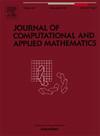样本的精确非参数序列收敛检验
IF 2.6
2区 数学
Q1 MATHEMATICS, APPLIED
Journal of Computational and Applied Mathematics
Pub Date : 2025-09-09
DOI:10.1016/j.cam.2025.117051
引用次数: 0
摘要
随机数生成器在科学中被广泛使用。伪随机数的生成是计算统计学中许多数据分析技术的基础。例如,这是大多数贝叶斯方法的情况,这些方法是通过采样器实现的,例如著名的吉布斯采样器和大都会-黑斯廷斯。这些经典的马尔可夫链蒙特卡罗采样器被设计用来生成一个数字序列,在某些条件下,收敛到一个序列,其行为就像从用户定义的目标分布中采样一样。一般来说,达到这种收敛所需的迭代次数是不确定的。有几个统计测试用于确定尚未实现的收敛,但不是用于实际信号收敛。本文介绍了一种精确的非参数序列检验,用于一般随机数发生器的收敛性信号。根据I型误差概率花费法,导出了求解方法。本文章由计算机程序翻译,如有差异,请以英文原文为准。
Exact non-parametric sequential convergence test for samplers
Random number generators are extensively used in science. Generating pseudo-random numbers is the base for many data analysis techniques in computational statistics. This is the case, for instance, of most of the Bayesian methods, which are enabled by means of samplers such as the well-known Gibbs sampler and the Metropolis–Hastings. These classical Markov Chain Monte Carlo samplers are designed to generate a sequence of numbers that, under certain conditions, converge to a sequence that behaves as if sampled from a user-defined target distribution. In general, the number of iterations required to reach such convergence is not deterministic. There are several statistical tests for identifying that convergence has not yet been achieved, but not for actually signaling convergence. The present work introduces an exact non-parametric sequential test for signaling the convergence of random number generators in general. The solution is derived in the light of the type I error probability spending approach.
求助全文
通过发布文献求助,成功后即可免费获取论文全文。
去求助
来源期刊
CiteScore
5.40
自引率
4.20%
发文量
437
审稿时长
3.0 months
期刊介绍:
The Journal of Computational and Applied Mathematics publishes original papers of high scientific value in all areas of computational and applied mathematics. The main interest of the Journal is in papers that describe and analyze new computational techniques for solving scientific or engineering problems. Also the improved analysis, including the effectiveness and applicability, of existing methods and algorithms is of importance. The computational efficiency (e.g. the convergence, stability, accuracy, ...) should be proved and illustrated by nontrivial numerical examples. Papers describing only variants of existing methods, without adding significant new computational properties are not of interest.
The audience consists of: applied mathematicians, numerical analysts, computational scientists and engineers.

 求助内容:
求助内容: 应助结果提醒方式:
应助结果提醒方式:


